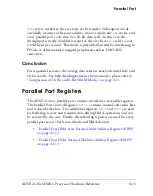
Using the Parallel Port
8-22
ADSP-2126x SHARC Processor Hardware Reference
Status Driven Transfers (Polling)
The second method that the core may use to manage parallel port transfers
involves the status bits in
PPCTL
register, specifically the Parallel Port Bus
Status (
PPBS
) bit. This bit reflects the status of the external address pins
AD0-AD15
and is used to determine when it is safe to disable and modify
the parallel port. The
PPBS
bit is set to 1 at the start of each transfer, and is
cleared once the entire 32-bit word has been transmitted/received.
Core-Stall Driven Transfers
The final method of managing parallel port transfers simply relies on the
fact that the core will stall execution when reading from an empty RX buf-
fer and when writing to a full TX buffer. This technique can only be used
for accesses to sequential addresses in external memory. For sequential
external addresses, the parallel port does not need to be disabled after each
word in order to manually update the
EIPP
register. Instead, the external
address that is automatically incremented by the modifier (
EMPP
) register
on each access is used.
Interrupt Driven Accesses
With interrupt-driven accesses, parallel port interrupts are generated on a
word-by-word basis, rather than on a block transfer basis, as is the case
when DMA is enabled. In this non-DMA mode, the interrupt indicates to
the core that it is now safe to read a word from the
RXPP
buffer or to write
a word to the
TXPP
buffer (depending on the value of the
PPTRAN
bit).
To facilitate this, the
PPI
(latch) bit of the
LIRPTL
register is set to one in
every core cycle where the
TXPP
buffer is not full or, in receive mode, in
every core cycle in which the
RXPP
buffer has valid data. When fast 16-bit
wide parallel devices are accessed, there may be as few as 10 core cycles
between each transfer. Because of this, interrupt-driven transfers are usu-
ally the least efficient method to use for core-driven accesses. Interrupt
driven transfers are most valuable when parallel port data-cycle durations
are very long (allowing the core may do some work between accesses).
Содержание ADSP-21261 SHARC
Страница 30: ...Contents xxx ADSP 2126x SHARC Processor Hardware Reference ...
Страница 40: ...Register Diagram Conventions xl ADSP 2126x SHARC Processor Hardware Reference ...
Страница 58: ...Differences From Previous SHARCs 1 18 ADSP 2126x SHARC Processor Hardware Reference ...
Страница 112: ...Secondary Processing Element PEy 2 54 ADSP 2126x SHARC Processor Hardware Reference ...
Страница 178: ...Summary 3 66 ADSP 2126x SHARC Processor Hardware Reference ...
Страница 204: ...DAG Instruction Summary 4 26 ADSP 2126x SHARC Processor Hardware Reference ...
Страница 322: ...Setting Up DMA 7 32 ADSP 2126x SHARC Processor Hardware Reference ...
Страница 436: ...SPORT Programming Examples 9 86 ADSP 2126x SHARC Processor Hardware Reference ...
Страница 521: ...ADSP 2126x SHARC Processor Hardware Reference 11 31 Input Data Port rts IDP_ISR end ...
Страница 522: ...Input Data Port Programming Example 11 32 ADSP 2126x SHARC Processor Hardware Reference ...
Страница 590: ...Timer Programming Examples 14 20 ADSP 2126x SHARC Processor Hardware Reference ...
Страница 796: ...I O Processor Registers A 174 ADSP 2126x SHARC Processor Hardware Reference ...
Страница 800: ...B 4 ADSP 2126x SHARC Processor Core Manual ...
Страница 846: ...Index I 36 ADSP 2126x SHARC Processor Hardware Reference ...














































